Exploring Moku Surf Hawaii: A Deep Dive into Surf Culture
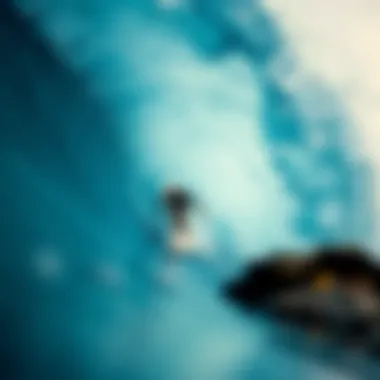
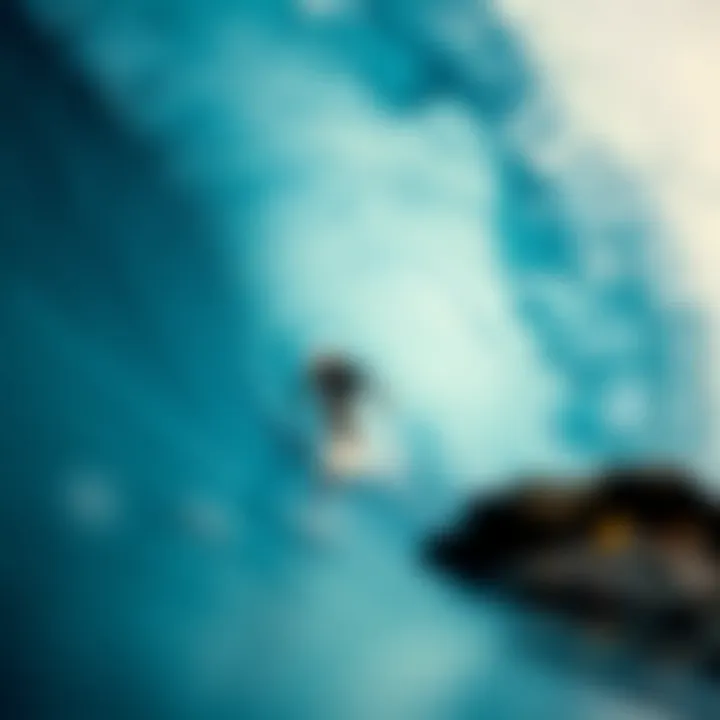
Intro
Moku Surf, nestled within the beauty of Hawaii, offers more than just waves; it's a cultural phenomenon. For those who dip their toes in the water or aficionados who dance with the ocean, understanding the layered significance of surf culture in Hawaii is paramount. This isn’t just about riding waves; it's a blend of artistry, environment, and heritage.
From the gentle lull of the ocean to the crashing waves, it’s crucial to delve into the nuances that define surf culture. This article aims to shed light on various aspects that make Moku Surf a remarkable experience. Surfing techniques tailored for beginners and veterans alike will be dissected, along with tailored recommendations on surfboard selection.
Moreover, we'll explore the intricate relationship between local ecosystems and the surfing community, ensuring that surfers appreciate and respect the land they enjoy. Travel tips for surf enthusiasts will also be shared, capturing the essence of what it means to bear witness to the powerful waves of Hawaii.
By the time you finish this guide, you’ll have a well-rounded understanding of Moku Surf that respects both its roots and its ongoing evolution.
Surfing Techniques
Surfing isn't just a sport; it's a way of life. Whether you're just getting started or looking to pull off an impressive maneuver, understanding the techniques behind this exhilarating activity is crucial.
Beginner Tips for Getting Started
For those new to surfing, the key lies in patience and practice. Here are some practical pointers to get your feet wet—figuratively and literally:
- Choose the Right Spot: Not every wave is meant for beginners. Look for gentle beach breaks rather than heavy reefs.
- Get the Right Equipment: Opt for a longer, wider board. This provides more stability and makes it easier to catch your first waves. A soft-top board can be ideal for novices.
- Learn the Fundamentals: Understand the basics of paddling, popping up, and maintaining balance. Connect with local surf schools; they often offer guidance tailored to the unique conditions of Moku surf spots.
- Keep an Eye on Safety: Always be aware of the surf and ocean conditions. Familiarize yourself with local customs and abide by surf etiquette.
Advanced Maneuvers and Tricks
Once you have a solid foundation, you may be eager to try more advanced techniques. This section is for those itching to elevate their surfing game:
- Cutbacks: Slice back towards the breaking wave on your board, allowing you to maintain the speed and rhythm of riding.
- Aerials: This requires more commitment, as it involves launching off the wave's lip and performing tricks in mid-air. Start with small jumps before attempting anything drastic.
- Floater: Gliding over the top of breaking waves is not just about balance, but also timing.
Remember—every surfer has their own journey. Progress takes time, and it's the thrill of mastering a new skill that makes surfing so rewarding.
Surfboard Selection
Your surfboard is your lifeline on the waves. Knowing how to choose the right one can significantly impact your surfing experience, whether you're a rookie or a seasoned pro.
Choosing the Right Board for Your Style
When selecting a surfboard, consider the following elements that can drastically influence your performance on the waves:
- Length and Width: Longer boards are great for catching waves early, while shorter boards offer maneuverability.
- Shape: Different shapes cater to different surf styles. For instance, fish tail boards excel in smaller waves while a thruster setup allows for versatility.
- Material: Foam boards are forgiving and great for beginners; fiberglass offers more durability and performance for juggling tricks.
Surfboard Maintenance and Care
Keeping your board in tip-top shape extends its life and enhances performance. Here are some simple maintenance tips:
- Rinse After Use: Saltwater and sand can wear down fin boxes and rails over time. A good rinse is essential.
- Store Properly: Keep your board out of direct sunlight and avoid extreme temperatures. A bag or rack can help protect it from damage.
- Check for Dings: Regularly inspect your board for any cracks or dents and repair them promptly.
"Regular maintenance isn't just about preserving a surfboard; it's about honoring the craft and the ocean it rides on."
Prolusion to Moku Surf
Moku Surf emerges not merely as a surfing venture but as a cultural cornerstone in the Hawaiian islands. Its relevance stretches beyond mere sport; it embodies a lifestyle, a community, and a deep respect for the ocean. This article will explore the various facets that define Moku Surf, particularly focusing on its history and significance in local culture. Here, surfing transforms into a conduit for connection with nature and heritage, establishing the foundation for understanding Hawaii's rich surfing traditions.
Historical Context
Hawaii's surfing roots trace back centuries, deeply woven into the fabric of Native Hawaiian life. The sport itself, known as he'e nalu in the native vernacular, was not just a pastime but a way of life, rich with spiritual significance. Kings and queens embraced surfing, elevating its status among the islands' elite. For instance, the famous King Kamehameha I was known for his prowess on the waves, which rallied followers around his leadership.
In the late 19th and early 20th centuries, surfing started to gain attention outside of Hawaii. Figures like Duke Kahanamoku played a pivotal role in popularizing the sport, introducing its exhilarating nature to the mainland US and beyond. His legacy continues to inspire generations of surfers, serving as a bridge between the historical significance of surfing in Hawaii and its modern-day appeal.
To understand Moku Surf fully, one must appreciate this historical continuum. It is a reminder of the ocean's power and the intricate relationship that Hawaiians have had with these waters long before surfing became a global phenomenon.
Cultural Significance
Diving into the cultural significance of Moku Surf, one discovers that it is not merely about riding waves. It's intertwined with respect for the environment, ancestral traditions, and the community’s spirit. The values of aloha and malama, meaning love and care respectively, resonate throughout the surfing community. This ethos emphasizes a stewardship that surfers uphold for the ocean, fostering a sense of responsibility among enthusiasts.
Moreover, surfing events are often community gatherings filled with local food, music, and camaraderie, celebrating both competition and connection. These aspects reinforce surfing as a communal activity rather than an isolated sport, fostering relationships and building a robust local identity.
"Surfing is a language of the ocean, and we surfers are just trying to speak it as best we can," reflects many who ride the waves in Hawaii. This sentiment captures the ongoing relationship surfers develop with the ocean, highlighting the importance of cultural expression through surfing activities.
In summary, Moku Surf is the crystallization of Hawaii's diverse historical narratives and its collective cultural voice. By engaging with this topic, this article aims to shine a light on not just the action of surfing itself, but the deeper currents that shape this exhilarating experience in the heart of Hawaii.
Geography of Hawaii's Surfing Spots
Understanding the geography of Hawaii’s surfing spots is crucial for both new and seasoned surfers. Hawaii is not just a tropical paradise; it’s a surfing heaven sculpted by nature's hand. The unique topography of these islands influences wave formation and conditions, offering a variety of surfing experiences that cater to different skill levels. From the majestic cliffs of Oahu to the serene beaches of Kauai, each location provides a distinctive surf vibe, attracting surf enthusiasts from all over the globe. The essence of surfing in Hawaii lies in its diverse landscapes and varying oceanic conditions, making geography a pivotal factor in this culture.
Key Locations for Surfing
Each island in Hawaii hosts unique surf spots that are beloved by the surfing community. Let’s delve into the major islands where surfing culture thrives, examining their strengths and what makes them special.
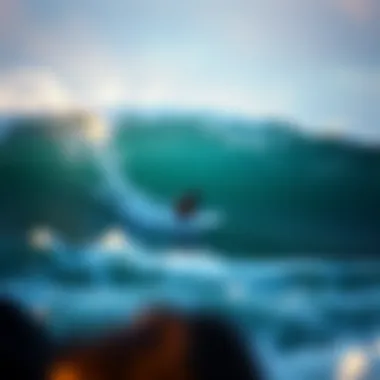
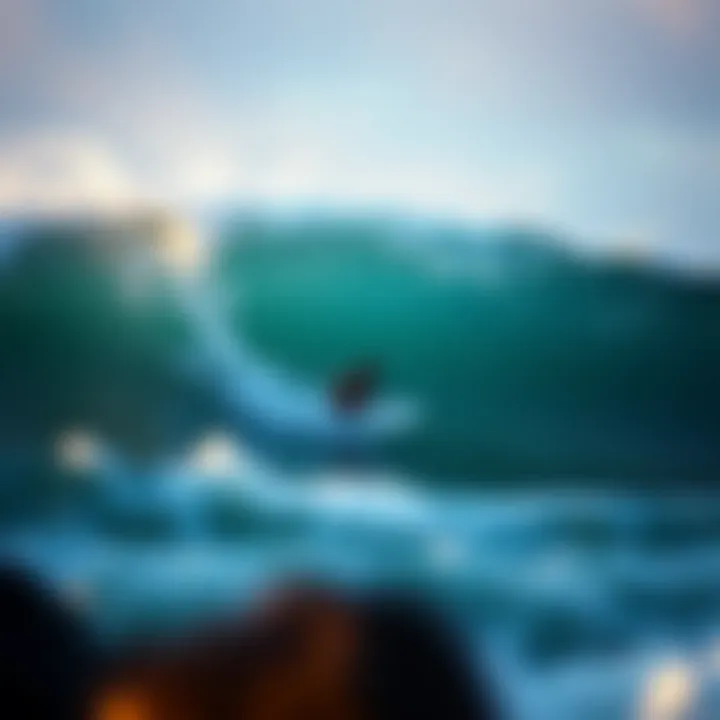
Oahu
Oahu, known as the
Moku Surf Equipment
The right equipment plays a vital role in the surfing experience, especially in the unique conditions found around Hawaii's coastal waves. This section dives into the various types of surfboards and essential gear that surfers, whether novice or seasoned, should consider when aiming to ride the perfect wave in Hawaii's iconic surf spots.
Types of Surfboards
Shortboards
Shortboards are the go-to choice for many surfers who seek performance and agility. Characterized by a length usually under six feet, these boards are designed for sharp maneuvers and quick turns. Their streamlined shape allows surfers to paddle quickly and dive into waves with ease. One key characteristic of shortboards is their pointed nose, which cuts through water with precision.
The popularity of shortboards in this article stems from their suitability for bigger waves often encountered around Hawaiian shores. They enable surfers to carve out explosive moves—ideal for those seeking adrenaline-fueled sessions. However, for beginners, shortboards can present a challenge, as stability becomes an issue while trying to balance. Many new surfers might find it easier to start on longer boards before transitioning to shortboards.
Benefits:
- Agility: Sharp turns and dynamic maneuvers are possible.
- Speed: Paddling into bigger waves is easier with a shorter length.
Disadvantages:
- Stability: May be hard to balance, particularly for inexperienced surfers.
- Learning Curve: More practice is required to master shortboarding.
Longboards
Longboards provide an entirely different experience, serving as a great tool for those wanting to enjoy the traditional aspects of surfing. Generally ranging from eight to twelve feet in length, these boards are wider and thicker than their shorter counterparts, contributing to greater stability and buoyancy. One of the main appeals of longboards is their ability to glide smoothly over smaller, gentler waves.
In the context of this article, longboards are favored for their easier handling, making them accessible for beginners. They allow surfers to practice fundamental skills such as paddling and balancing with less strain. The unique feature of longboards lies in their nose, which often supports the art of noseriding, an advanced technique that highlights style over sheer performance.
Benefits:
- Stability: Easier to balance and ride for novices.
- Versatility: Suitable for different wave conditions, particularly smaller ones.
Disadvantages:
- Weight: Can be cumbersome to carry and maneuver.
- Speed: Less maneuverable in steep, fast waves compared to shortboards.
Fish Boards
Fish boards, with their distinctive swallowtail design, combine features of both shortboards and longboards, making them a versatile choice. With a typically shorter length, fish boards are wider and designed to help surfers catch waves more easily. They excel in smaller surf conditions but still allow for some aggressive turning and maneuvering.
This makes fish boards an attractive choice for surfers visiting Hawaii, where conditions can vary dramatically. Another benefit of fish boards is that they often come with multiple fins, providing altered performance options on different wave types. However, due to their shape, they might not perform as well in large surf, thus limiting their use in specific scenarios.
Benefits:
- Easy Wave Catching: Ideal for smaller waves due to their width.
- Fun Factor: Offers playful performance variants from traditional shortboards.
Disadvantages:
- Limitations in Large Waves: Not always suitable for bigger, challenging surf conditions.
- Preference Specific: Not all surfers appreciate the feel of fish boards compared to standard shortboards or longboards.
Essential Gear for Surfers
As any surfer will attest, equipment goes beyond just the board. Essential gear enhances safety and performance, contributing greatly to the overall riding experience in Moku surf.
Wetsuits
The ocean temperature varies, primarily influenced by the seasons and specific locations within Hawaii. Enter the wetsuit – essential for staying warm and protected from the elements while surfing. Wetsuits come in various thicknesses and designs tailored to different water temperatures. A key characteristic is their insulating ability, which allows surfers to comfortably spend time in cooler waters without feeling the chill.
Wetsuits are particularly beneficial for those surfing early in the morning or later in the evening when temperatures drop. While they can be somewhat tricky to put on at first, their unique feature of providing buoyancy can aid surfers in paddling out and catching waves more comfortably.
Benefits:
- Insulation: Retain body warmth in cooler waters.
- Buoyancy: Helps improve paddling efficiency.
Disadvantages:
- Mobility: Can feel restrictive for some surfers.
- Cost: Good-quality wetsuits tend to come with a higher price tag.
Leashes
In the thrilling world of surfing, a leash is a small but mighty piece of equipment. Surf leashes connect the surfer's ankle to the board, ensuring that when the rider wipes out, the board doesn't get lost in the waves, posing a hazard to others and simplifying retrieval. The highlight of a good leash is its strength and elasticity, providing a balance between durability and comfort.
The importance of leashes cannot be overstated, especially in crowded surf spots where one stray board could lead to accidents. For surfers interested in safety and functionality, utilizing a proper leash can make all the difference between a smooth session and a disastrous one.
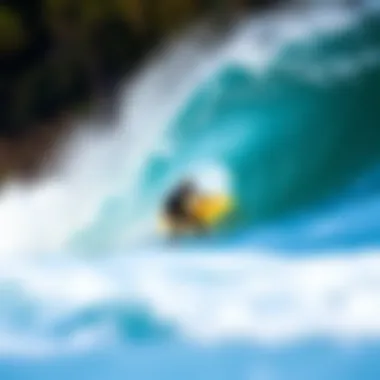
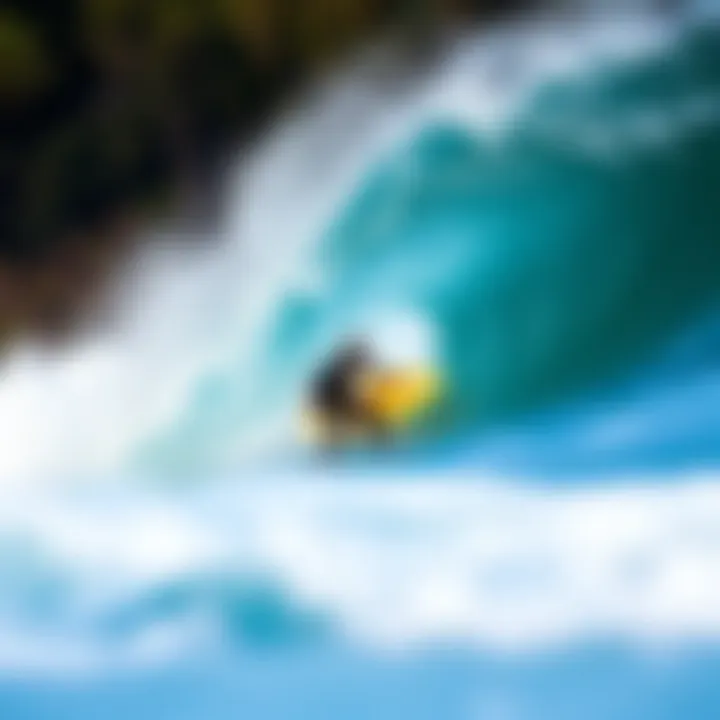
Benefits:
- Safety Concerns: Reduces risks to others in the water.
- Convenience: Facilitates quick recovery of the board.
Disadvantages:
- Wear and Tear: Can break if not checked regularly.
- Obscured Freedom: Some surfers feel restricted by the attachment.
Accessories
Accessories are often the unsung heroes of a surfer's lineup. They include items such as wax for maintaining traction on the board, sunblock to protect against harmful UV rays, and even surf hats. Each accessory serves a specific purpose, enhancing both performance and comfort in the water.
In this article, recognizing the role of accessories ensures that surfers are well-prepared for their adventures. For example, using the right wax can significantly improve grip, which in turn translates to better performance on the waves. Accessories might be seen as additional costs; however, when considering the overall surfing experience, they are just as essential as the board itself.
Benefits:
- Performance Improvements: Enhances grip and comfort.
- Protection: Guards against environmental conditions.
Disadvantages:
- Extra Cost: Can add up depending on individual needs.
- Bulkiness: Carrying multiple items can be cumbersome during travel.
In summary, understanding Moku surf equipment and its nuances, from various surfboards to essential accessories, is crucial for anyone looking to thrive in the surfing scene of Hawaii. Whether a rider is slicing through powerful waves or gliding gracefully on gentle swells, having the right tools and knowledge in hand makes a world of difference.
Techniques for Thriving in Moku Surf
When diving into the vibrant world of Moku Surf, mastering specific techniques is not just beneficial; it's often essential. These skills form the backbone for both novice and seasoned surfers, shaping the way they interact with the waves and the ocean. Understanding and practicing these techniques enhances the overall surfing experience, making it more enjoyable and safer.
Fundamental Skills
Paddling
Paddling is the lifeblood of surfing. It serves as the gateway to catching waves and navigating the ocean. Good paddling technique allows surfers to efficiently paddle out to the lineup, positioning themselves for optimal wave rides. Key characteristics of effective paddling include strong, rhythmic strokes, maintaining a streamlined body position to reduce drag.
One of the great advantages of honing this skill is that it builds overall fitness, enhancing upper body strength and core stability. However, poor paddling can lead to frustration during surf sessions, as struggling to paddle out can tire surfers before they have even caught a wave.
Balancing
Balancing is critical when standing on the surfboard. It’s not just about keeping upright; it’s about maintaining control while maneuvering through waves. Proper balance can dramatically enhance a surfer's stability and agility on the board. A key characteristic of balancing lies in distributing weight evenly and keeping a low center of gravity. Basketball players often say, "It's all about your base." This is true in surfing too - without a solid base, attempting tricks becomes a risky business. Balancing takes time to master, but once achieved, it opens the door to more adventurous riding techniques.
Turning
Turning is where a surfer expresses style and creativity. It’s not enough to simply ride the wave; knowing how to turn effectively enhances the surfing experience and the thrill of riding dynamic waves. The key characteristic here involves shifting weight, engaging the rail of the board, and using the arms for guidance.
Turning smoothly also allows surfers to adapt to changing wave conditions and evade potential wipeouts. There’s a slight learning curve, but mastering the art of turning makes all the difference when navigating big swells.
Advanced Maneuvers
Aerials
Aerials represent the pinnacle of surfing maneuvers, combining skill, speed, and a dash of bravado. Engaging in aerials adds an exhilarating dimension to surfing, captivating both surfers and spectators alike. The key characteristic of aerials is the ability to generate momentum through speed off the lip of the wave. This requires a unique combination of timing and body control. While aerials are visually stunning, they do come with the risk of falling from substantial heights. The thrill does come at a price, as mastering aerials takes time and dedication.
Cutbacks
Cutbacks are all about versatility and control. They allow surfers to change direction while maintaining speed, showcasing a surfer's agility. The key characteristic here is how to pivot back towards the breaking part of the wave while keeping your speed. Furthermore, cutbacks help surfers refine their surfing style, allowing them to ride a wave’s energy efficiently. However, newcomers may find it challenging to time and execute these maneuvers properly, resulting in wavering confidence.
Tube Riding
Last but certainly not least, tube riding is often considered the holy grail of surfing. It involves riding inside the wave’s hollow section, or tube. This advanced maneuver stems from a surfer’s ability to read the wave and surf it at just the right moment, positioning oneself perfectly as the wave breaks.
The thrill of being enveloped by water is unmatched, yet it is imperative to understand wave dynamics to safely and effectively execute this maneuver. Mastering tube riding can elevate a surfer’s reputation in the local surf community.
The techniques discussed serve not just as tools for better performance but as gateways to deeper connection with the ocean and surf culture itself.
As surfers build these techniques, they not only improve their skills but also enrich their overall experience in the Moku Surf. With dedication to mastering these techniques, surfers enhance their enjoyment while fostering respect for the ocean and surf culture.
The Role of Local Ecosystems
Local ecosystems play a vital role in the art of surfing, particularly in a place as rich in biodiversity as Hawaii. The surfing experience does not exist in a vacuum; rather, it’s deeply intertwined with the natural environment that surrounds it. From the delicate balance of marine life to the health of the coral reefs, every aspect influences not only the quality of surf but also the sustainability of the sport itself.
Environmental Considerations in Surfing
When surfers paddle out to catch a wave, they are engaging with a complex ecosystem that deserves respect and understanding. The health of coastal communities, marine habitats, and even the physical landscape itself can directly impact the surfing experience. For instance, pollution from development or tourism can deteriorate water quality, posing health risks to surfers and harming marine life in the process.
A few major points to consider:
- Pollution: Surfers often rely on clean waves and pristine beaches. Chemical runoff, plastic waste, and sewage can lead to dangerous conditions for surfers and damage local ecosystems.
- Marine Life Protection: Certain areas are breeding grounds for sensitive species like sea turtles and manta rays. Surfers must be aware of these habitats to help minimize disruption and support conservation efforts.
- Erosion: Coastal erosion can change wave patterns and beach landscapes. Responsible surfing practices include not only respecting local wildlife but also advocating for measures that mitigate erosion.
Surfers are encouraged to familiarize themselves with the environmental conditions of the sites where they endeavour to ride waves. Not only does this ensure their own safety, but also fosters a connection to the surroundings that enhance the beauty and enjoyment of the surfing experience.
Conservation Efforts
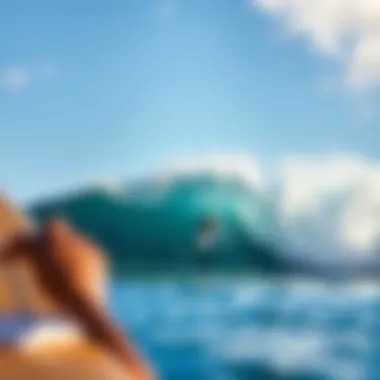
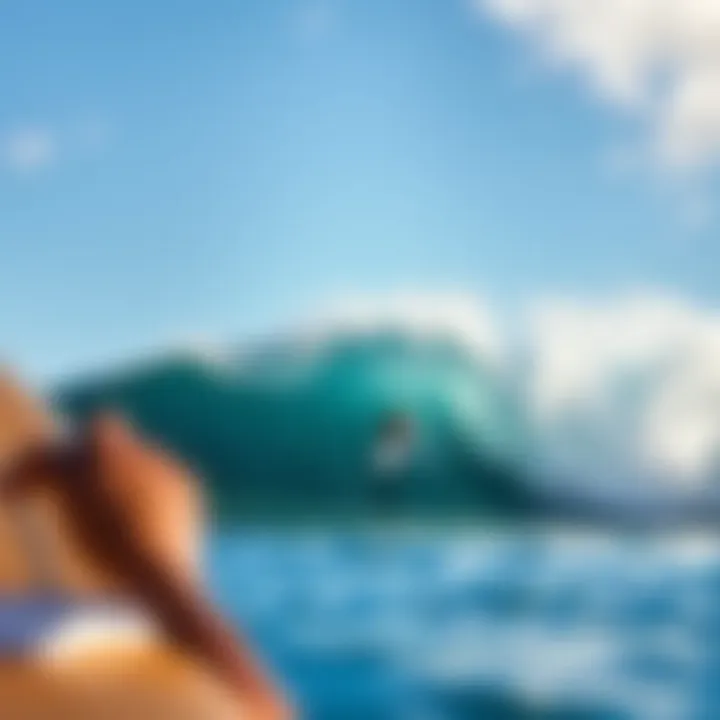
Conservation is key to maintaining the vibrant ecosystems that support both surfing and marine life. Several efforts in Hawaii showcase how surfers and local communities can unite for environmental protection. Here’s how these procedures stand out:
- Beach Clean-Up Initiatives: Numerous local groups organize regular clean-up events on popular surf beaches to remove trash and debris. These efforts not only beautify the area but also promote community engagement among surfers and non-surfers alike.
- Marine Protected Areas: Designating certain coastal zones as protected environments helps to ensure the preservation of critical habitats. These areas often allow for controlled surfing access, promoting awareness and sustainable practices.
- Educational Programs: Surf schools and organizations increasingly implement programs teaching new surfers about ocean safety and environmental responsibility. Educating surfers about marine ecosystems cultivates an appreciation of the ocean that goes beyond simply riding waves.
"A healthy ocean is the foundation of every surfer's journey. Protecting it ensures we can ride waves for generations to come."
Traveling to Moku Surf in Hawaii
Traveling to Moku Surf presents an exciting opportunity for surfers and adventure seekers alike. This section delves into the essential considerations for planning a trip to this surfing paradise. Understanding how to navigate your visit is crucial, not just for the sake of convenience but to enhance your overall experience.
Best Times to Visit
The prime time for surfing in Hawaii generally falls between late fall through early spring, when wave swells are particularly strong. Specifically, December through February is often referred to as the "big wave season," particularly for spots like Waimea Bay on Oahu’s North Shore. Surfers who thrive on challenging waves flock during this period.
However, if you’re new to surfing and prefer smaller, more manageable conditions, visiting during spring or late summer may suit you better. During these times, the waves are gentler, offering novice surfers an excellent opportunity to hone their skills. Ultimately, the best time to visit boils down to your surfing proficiency and adaptability.
Accommodation Options
When visiting Moku Surf, determining where to stay can significantly affect your experience. Options range from upscale resorts to budget-friendly hostels, allowing you to choose based on both budget and preferences.
Resorts
Resorts such as the Four Seasons Resort Hualalai provide a luxurious retreat after a day of surfing. These accommodations usually boast amenities like oceanfront views, gourmet restaurants, and top-notch facilities tailored for relaxation and adventure.
A key characteristic of resorts is their all-inclusive offerings. This is particularly appealing as you can enjoy guided surf lessons, spa treatments, and other recreational activities—all on site. Nonetheless, the high price point can be a disadvantage for budget-conscious travelers, limiting access to this type of experience for some surf enthusiasts.
Hostels
Opting for hostels, like HI Hostel in Waikiki, can be a more vibrant and economical choice. Hostels foster a communal atmosphere that appeals to younger travelers and those looking for a less formal setting. One primary advantage of hostels is the opportunity to meet fellow surfers and exchange tips on the best surf spots.
However, while hostels offer affordability and interaction, they often lack some privacy and comfort found in more upscale options, which can be a drawback for some.
Camping
For those keen on immersing themselves in nature, camping can provide a unique experience. Many beaches offer designated camping areas where surfers can set up tents right by the water. Not only does this option allow for a closer connection to the ocean, but it also typically comes at a lower cost.
The primary appeal of camping is enjoying the close-knit community of fellow enthusiasts and the stunning ocean views right from your campsite. On the flip side, it's crucial to consider the lack of amenities and potential challenges of local wildlife, which may deter some from choosing this option.
Ultimately, whether you prefer the plush comforts of a resort, the vibrant community in a hostel, or the raw experience of camping, Moku Surf offers diverse accommodations catering to each traveler’s unique needs. The choice you make can significantly shape your surf adventure and overall enjoyment of Hawaii’s breathtaking coastline.
The Community of Moku Surfers
The community of Moku surfers is not just a collection of individuals riding waves, but rather a vibrant tapestry of culture, camaraderie, and shared passion. This sect of surf culture weaves together the intrinsic values related to environment, respect, and the thrill of the ocean. Surfers often develop a close-knit bond with one another, reinforcing the idea that surfing is not merely a sport but a way of life. In this section, we dissect the nuances of local surf culture and the events that bring this community together.
Local Surf Culture
Local surf culture in Hawaii carries tales that go beyond the sport itself. It's about the stories passed down through generations, instilling a deep-seated respect for the ocean. Each surf spot has its own culture, shaped by the local community's traditions and history. For instance, surfers at Waimea Bay exhibit a unique blend of camaraderie and competitiveness. Locals take pride in their ability to ride the infamous big waves, often referring to this skill as a rite of passage.
Membership within this community requires not only proficiency on a surfboard but also an understanding of the unwritten rules that govern local etiquette. Surfers are encouraged to show appreciation towards nature and the waves they ride, practicing what is known as 'Aloha spirit'. This means respecting the ocean, fellow surfers, and the land itself. Such principles often extend to community efforts that aim to protect fragile coastal ecosystems.
"The ocean, it's like an old friend. You learn to listen to its moods, and it teaches you respect."
Moreover, the language of surfing is often unique and full of local slang. Words such as 'kook' for a novice or 'shaka' for the gesture of friendship underscore the strong traditions tied to surf culture. This shared lexicon fosters a sense of belonging, making newcomers feel like they are part of something larger than themselves.
Events and Competitions
Events and competitions play a crucial role in fortifying the bonds within the Moku surfing community. They are not merely opportunities to showcase skills but also celebrations of culture and personal triumphs. Take, for instance, the annual Vans Triple Crown of Surfing, which gathers elite surfers from all over the globe to compete at the famed Banzai Pipeline. The energy during this time is palpable, as locals gather to support both their own and visiting competitors.
These competitions serve multiple purposes: they highlight a competitive spirit while simultaneously educating newcomers on the importance of sportsmanship. Whether someone triumphed in a heat or faced disqualification, the learning experience transcends the scoreboard.
In addition to the adrenaline of competitions, local events such as surf festivals and beach clean-ups foster community spirit. Participants engage not only in performances or workshops but also in dialogues about sustainability, sharing insights on ocean conservation efforts. Activities like these serve to unify the community under a common cause, advocating for environmental stewardship while still celebrating their love for the sport.
Overall, the community of Moku surfers thrives on a foundation of shared experiences, local traditions, and an unwavering passion for the ocean. By embedding themselves in this culture, surfers not only ride waves but also navigate through a lifestyle that honors Hawaii's rich maritime heritage.
End: Moku Surf's Influence
The impact of Moku Surf within Hawaii's surf culture is a testament to the deep-rooted traditions and ever-evolving nature of this beloved sport. Surfing is not simply a pastime here; it embodies a lifestyle and a form of expression that influences various aspects of life in Hawaii. As such, the legacy of Moku Surf serves as a cornerstone around which surf enthusiasts converge, celebrating not just the waves but the bond forged by a shared passion.
The Legacy of Moku Surf
Moku Surf holds a unique position in the annals of Hawaiian surfing history. It reflects generations of surfer's dedication, technology advancements in surfboard design, and the unwritten rules of surf etiquette that have been handed down through the years. The stories of legendary surfers who carved their names into the waves off Hawaiian coastline are celebrated, echoing through local surf shops and schools.
"To surf is to connect with the ocean, to feel its rhythm and respect its power. It teaches patience and humility, lessons as vital as the waves themselves."
This legacy is not merely about catching waves, but about respecting the ocean and preserving its beauty. Moku Surf becomes a living repository of cultural practices, including the reinstatement of traditional Hawaiian practices concerning marine conservancy. These practices help keep the delicate ecosystems intact, ensuring future generations can revel in the beauty Hawaii has to offer.
Future of Surfing in Hawaii
Looking ahead, the future of surfing in Hawaii is poised for transformative growth. The wave of innovations in surfing gear—whether through eco-friendly materials or enhanced designs—reflects a community increasingly aware of its environmental responsibilities. The surf culture is also shifting to embrace inclusivity, welcoming more diverse groups into the fold. Programs aimed at educating newcomers and fostering skills among underrepresented communities are emerging. This creates a rich tapestry of voices and experiences that only strengthens Moku Surf’s community.
Moreover, with technological advances in wave forecasting and surfboard design, surfers can look forward to an elevated experience that enhances their time in the water. However, this progress does not come without challenges. Ensuring the preservation of the surf environment amid rising tourism and coastal development is crucial. It’s vital that the values of respect and sustainability remain at the forefront of surf culture.



